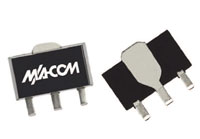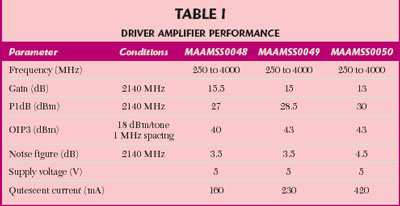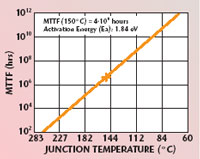
As consumers adopt more data intensive applications and want access to that data in more locations, the need for high speed wireless data communications is increasing dramatically. There are a host of wireless standards emerging to satisfy this need for increased data. 2.5G/3G, Wi-Fi and WiMAX systems are all vying for their share of the data network.
The amount of data transmitted relates to the available bandwidth. Unfortunately, bandwidth for these systems is not unlimited and turns out to be a scarce, valuable commodity. This forces system designers to develop more complex modulation schemes to increase the spectral efficiency and transmit more data in a given frequency channel. Complex modulation schemes place a premium on system linearity to maintain the integrity of the transmitted data. While any component in a transmit-receive communications system can introduce distortion and nonlinearities to a signal, the transmit amplifier chain is a significant contributor because this is one of the last operations performed on the signal before it is radiated.
To address the need for higher linearity in the transmit amplifier chain for a wide variety of emerging wireless data standards, M/A-COM is expanding its portfolio of amplifiers by introducing a family of broadband, high linearity driver amplifiers. The MAAMSS0048, MAAMSS0049 and MAAMSS0050 are gain blocks with output P1dB levels of +27, +28.5 and +30 dBm, respectively. These driver amplifiers are suitable for 2.5G/3G, Wi-Fi, WiMAX and a host of other applications. All the amplifiers in this family are housed in lead-free, RoHS-compliant, SOT-89 plastic packages.
This amplifier family is fabricated using a GaAs HBT process and achieves high intercept performance over a 20 dB power range. The usable bandwidth for this family of amplifiers is very broad. Each of the three driver amplifiers covers 250 to 4000 MHz. The user tunes the amplifier to optimize performance for a specific frequency range with external matching components. The data sheets for these devices contain recommended layouts and tuning schemes for a variety of wireless frequencies. The IC Products Applications Group of M/A-COM should be contacted for frequency requirements not covered by the tuning layouts shown in the data sheets. This group works with customers to specify the best tuning scheme for a particular requirement.

The layout shown in Figure 1 is suggested for a 2110 to 2170 MHz operation. After using this tuning recommendation, measurements were performed on the three amplifiers mentioned. Figure 2 shows their gain versus output power performance at 2170 MHz, while Figure 3 plots their output IP3 versus power output at 2140 MHz. These plots show that the gain and output intercept point performance stay very flat up until the amplifiers start to compress. This small variation over output power ensures that the system performance is well behaved. The performance for this family of driver amplifiers is summarized in Table 1.

Fig. 1 2150 MHz tuning scheme for the MAAMSS0050 amplifier.

Fig. 2 Output power at 2170 MHz, using the suggested tuning scheme. | 
Fig. 3 Output third-order intermodulation product versus output power. | 
Fig. 4 MAAMSS0048 device junction temperature versus output power for four different frequencies. |
To ensure the reliability of this class of amplifiers, the company has performed extensive temperature stress testing. These accelerated thermal stress tests, for devices produced with the HBT process, yield data points on a lifetime versus junction temperature plot. By plotting the best-fit curve through these points, the slope constant and activation energy (Ea) are determined using the classic Arrhenius life-stress relationship. Using this relationship, the mean time to failure (MTTF) can be determined for any junction temperature. By carefully measuring the input power, output power and DC dissipation, the total power dissipation within the junction of the amplifier can be determined. This, coupled with the thermal resistance, determines the junction temperature. Figure 4 summarizes these results for the MAAMSS0048 at four frequencies between 2110 and 2170 MHz. From this data, the junction temperature can be conservatively set at +150°C (at an ambient of +85°C) in the Arrhenius plot. From the plot of mean time to failure versus temperature, shown in Figure 5, an MTTF of 4 × 106 hours is achieved for this family of amplifiers operating at a maximum junction temperature of 150°C.

Fig. 5 MTTF versus device junction temperature for the high linearity RF driver amplifiers.
In summary, a family of high output intercept point, broad bandwidth driver amplifiers with P1dB levels of +27, +28.5 and +30 dBm has been developed. These devices come in lead-free, RoHS-compliant, SOT-89 packages for easy surface-mount assembly. The broad frequency coverage and external tuning make them suitable for a variety of wireless applications.
For higher gain amplifiers, M/A-COM will soon be extending its family of drivers with MAAMSS0056, MAAMSS0057 and MAAMSS0058. These are two-stage amplifiers with output P1dB levels of +27, +30 and +33 dBm, respectively.
M/A-COM Inc.,
Lowell, MA
(800) 366-2266,
www.macom.com.
